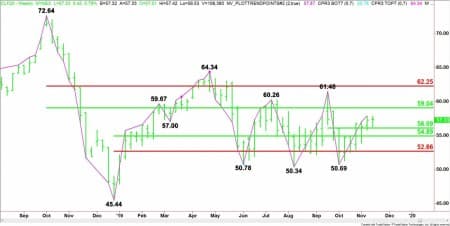U.S. West Texas Intermediate crude oil futures are in a position to finish flat for the week. The price action was driven this week by two-sided news about the progress of U.S.-China trade relations, and renewed worries over demand, driven by reports from OPEC and the Energy Information Agency. This week’s government inventories report was also bearish, however, the focus didn’t seem to be about supply this week, but rather future demand growth due to the impact of the on-going trade war on the global economy.
US-China Trade News Fuels Two-Sided Response
This week has been filled with a few headlines regarding trade issues but nothing hard-hitting enough to think a partial-trade deal was imminent. Crude oil prices responded to two-sided headlines by trading accordingly – bearish news pressured prices, bullish news supported prices.
The week started with worries that President Donald Trump had not agreed to the rollback in tariffs that a China announced on November 7. Last Friday, Trump said, “China would like to get somewhat of a rollback, not a complete rollback, ‘cause they know I won’t do it. I haven’t agreed to anything.”
Then on November 12, President Trump said the United States will increase tariffs on Chinese goods if the first step of a broader trade agreement isn’t reached.
“If we don’t make a deal, we’re going to substantially raise those tariffs,” he said in a speech to the Economic Club of New York. “They’re going to be raised very…
U.S. West Texas Intermediate crude oil futures are in a position to finish flat for the week. The price action was driven this week by two-sided news about the progress of U.S.-China trade relations, and renewed worries over demand, driven by reports from OPEC and the Energy Information Agency. This week’s government inventories report was also bearish, however, the focus didn’t seem to be about supply this week, but rather future demand growth due to the impact of the on-going trade war on the global economy.
US-China Trade News Fuels Two-Sided Response
This week has been filled with a few headlines regarding trade issues but nothing hard-hitting enough to think a partial-trade deal was imminent. Crude oil prices responded to two-sided headlines by trading accordingly – bearish news pressured prices, bullish news supported prices.
The week started with worries that President Donald Trump had not agreed to the rollback in tariffs that a China announced on November 7. Last Friday, Trump said, “China would like to get somewhat of a rollback, not a complete rollback, ‘cause they know I won’t do it. I haven’t agreed to anything.”
Then on November 12, President Trump said the United States will increase tariffs on Chinese goods if the first step of a broader trade agreement isn’t reached.
“If we don’t make a deal, we’re going to substantially raise those tariffs,” he said in a speech to the Economic Club of New York. “They’re going to be raised very substantially. And that’s going to be true for other countries that mistreat us too.”
China is “dying” to make a trade deal with the U.S., Trump said, adding that he’ll sign it only if it’s good for American companies and workers. Still, he said, “we’re close – a significant Phase 1 deal could happen soon.”
On November 13, CNBC said, “The high-stakes trade negotiations between the U.S. and China are running into trouble as the two countries attempt to finalize a limited trade agreement.”
The Wall Street Journal first reported the roadblock in the trade talks, adding China is hesitant to commit to a specific amount of agricultural products in the text of a potential deal.
On November 14, Chinese Ministry of Commerce spokesman Gao Feng said that both countries are holding deep discussions about a “phase one” deal, but noted that the rolling back of some tariffs is key to reaching an agreement.
“The trade war was begun with adding tariffs, and should be ended by canceling these additional tariffs. This is an important condition for both sides to reach an agreement,” Fend said Thursday at a weekly press conference.
Later on Thursday, White House economic adviser provided another ray of hope when he said negotiations over the first phase of a trade agreement with China were coming down to the final stages, with the two sides in close contact.
Speaking after an event at the Council on Foreign Relations late Thursday in Washington, Kudlow told reporters that a deal was close though “not done yet.”
“We are coming down to the short strokes,” Kudlow said. “We are in communication with them every day right now.”
OPEC Expects Demand to Fall
Early Friday, prices rose after OPEC said it expected demand for its oil to fall in 2020. OPEC said demand for its crude would average 29.58 million barrels per day next year, 1.12 million bpd less than in 2019. That points to a 2020 surplus of about 70,000 bpd, which is less than indicated in previous reports. This news supported prices early Friday.
OPEC+ Faces ‘Major Challenge’ from Competitors Surging Output: IEA
The early strength didn’t last and the markets turned lower after the IEA said on Friday, OPEC and its friends face stiffening competition in 2020, adding urgency to the oil producer group’s policy, according to Reuters.
“The OPEC+ countries face a major challenge in 2020 as demand for their crude is expected to fall sharply,” the Paris-based agency said in a monthly report.
The IEA estimated non-OPEC supply growth would surge to 2.3 million barrels per day (bpd) next year compared to 1.8 million bpd in 2019, citing production from the United States, Brazil, Norway and Guyana.
“The hefty supply cushion that is likely to build up during the first half of next year will offer cold comfort to OPEC+ ministers gathering in Vienna at the start of next month,” it added.
While U.S. supply rose by 145,000 bpd in October, the IEA said, a slowdown in activity that started earlier this year looks set to continue as companies prioritize capital discipline.
Demand for crude oil from OPEC in 2020 will be 28.90 million bpd, the IEA forecast, 1 million bpd below the exporter club’s current production.
Technical Analysis
Weekly January West Texas Intermediate Crude Oil Technical Analysis

Weekly Swing Chart Analysis
The main trend is up according to the weekly swing chart, however, short-term momentum is neutral.
A trade through $61.48 will reaffirm the uptrend. A move through $50.69 will change the main trend to down.
The short-term range is $61.48 to $50.69. Its 50% level or pivot is $56.09. The market is trading on the strong side of this level, giving it an upside bias.
On the upside, the main target zone is $59.04 to $62.25. The downside target is $54.89 to $52.66.
Weekly Swing Chart Forecast
Based on this week’s price action, the direction of the January WTI crude oil futures contract the week-ending November 22 is likely to be determined by trader reaction to the short-term pivot at $56.09.
Bullish Scenario
A sustained move over $56.09 will indicate the presence of futures. If this move creates enough upside momentum then look for the rally to possibly extend into the main 50% level at $59.04.
Bearish Scenario
A sustained move under $56.09 will signal the presence of sellers. This could drive the market into a 50% level at $54.89. This price is also the trigger point for an acceleration to the downside with $52.66 a potential downside target.
Conclusion
The US-China trade ordeal is likely to continue to produce two-sided price action until an agreement is reached. This should trigger a spike in prices to the upside. If both parties decide to take a break then look for prices to plunge.
No deal means low demand growth. This increases the chances of OPEC and its allies making a decision to make deeper production cuts at their December 5-6 meeting. This news could prop up prices.


















